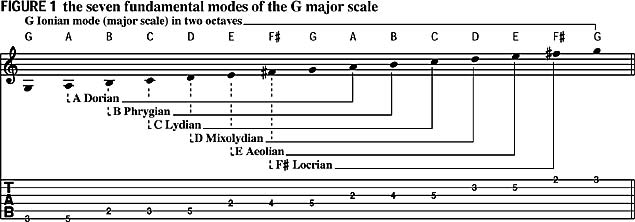|
by Joe Satriani
Getting familiar with modal sounds.
Learning the modes was, for me, a three-tiered experience. The first part involved recognizing that there were
sounds out there that were new to me and developing a strong desire to investigate what those sounds were
about. The second part was learning the theory of how modes are constructed and how they relate to each
other. The third phase began with a few weeks of intense personal musical discovery, spent practicing
voraciously and learning how to apply modes to real musical situations. Though this was many years ago, I
feel that I’m still in this boundless phase of learning and exploration.
 Of course, it’s necessary to learn to walk before you can run. With this in mind, the following is a clear
theoretical breakdown of how the seven fundamental modes are derived from the major scale. FIGURE 1
illustrates the G major scale (G A B C D E F#) and shows how seven different modes are generated using the
same seven notes arranged in different orders. The first mode, G Ionian, is identical to the G major scale. The
second mode, A Dorian (A B C D E F# G), is formed by beginning on the second scale degree of the G major
scale, A, and ascending, through the same set of notes, to the A note one octave higher. The third mode, B
Phrygian, is produced by starting on the third scale degree of the G major scale, B, and ascending to the
octave B note.
Here’s the magic formula you’ll need to memorize in order to teach yourself the seven modes in all 12 keys:
the Ionian mode is the same as the major scale; the Dorian mode is formed by beginning and ending on the
second degree of the major scale; Phrygian is the major scale starting on the third degree; Lydian starts on
the fourth note of the major scale; Mixolydian, Aeolian and Locrian begin on the fifth, six and seventh major
scale degrees, respectively.
 When learning the seven fundamental modes, it definitely helps to think of each mode as simply being a
different orientation of its parent major scale. Ultimately, however, it’s better to break away from this relative or
associative way of thinking and look at each individual mode as being its own harmonic entity. Each of the
seven modes comprises a different sequence of half steps and whole steps that gives it its characteristic
harmonic quality, or “color.”
As I explained last month, to convey the sound of a mode to the listener, it’s not enough to just play the notes
in a particular position on the fretboard; the mode’s root note or tonal center (the first note of the mode) must
be clearly established in the listener’s ear. For example, if you’re improvising in the B Phrygian mode (B C D
E F# G A), the notes need to be heard in the context of a B tonal center. One way to ensure that you’re
conveying the intended B Phrygian modality is to play the melody notes over a B bass note or some kind of B
chord that contains notes that fall within the mode, such as B5, Bm, Bm7, Bsus4, B7sus4 or B7b9sus4.
 Another thing that helps to establish a mode’s tonal center is to emphasize the root note in the melody you’re
composing or improvising. This can be particularly challenging if there’s no accompaniment. In the example
given above, the musical color of B Phrygian would need to be clearly communicated to the listener to avoid
any harmonic ambiguity. The most important note would be B, the root note, and all of the other notes in the
mode should surround and relate to that note. If you were to forever rely on the musical crutch of thinking “G
major,” you’d prevent yourself from truly expressing yourself in a musically convincing and artistic way in the B
Phrygian mode.
 The best way to really get to know the structure and sound of all seven fundamental modes is to compare
them back-to-back in the same (or parallel) key, beginning each mode on the same root note (G Ionian, then
G Dorian, then G Phrygian, etc.). By playing and listening to the different modes this way, as opposed to
practicing them only in their theoretically relative tonal centers (G Ionian, then A Dorian, then B Phrygian,
etc.), one can easily analyze and appreciate the differences and similarities in their intervallic structures and
harmonic colors.
FIGURE 2 illustrates all seven fundamental modes played in parallel fashion in the key of G. Memorize the
intervallic structure of each mode, as well as the fingerings, and record yourself playing a low G bass note so
you can practice playing the mode while hearing it in an appropriate musical context. Also, try to figure out
how to extend each mode an octave higher, then try playing it in different areas of the fretboard and, finally, in
different keys.
It will take a dedicated effort to learn the modes inside out. But learning them is an essential rite of passage
for any serious player, so set aside time every day to master them.
|